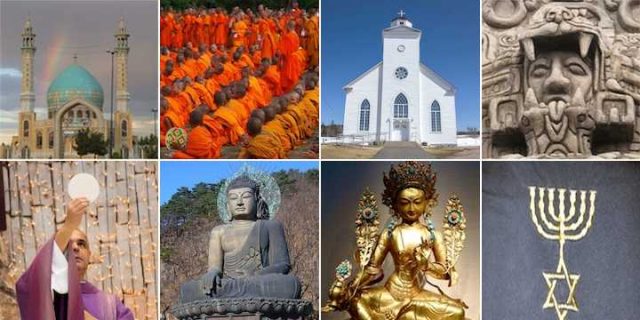This page in brief
Do you ever wonder if, in the end, all religions are the same? Could any of the world’s religions be God’s way of revealing himself?
Check out the different types of religions, and decide for yourself.
A brief guide to the major religions
There are many religions in the world, but books on comparitive religion often refer to the twelve major religions which together are believed by more than 80% of the world’s population. Some of the main features of these 12 religions are shown at 10 facts about 12 major religions. These religions can be broadly grouped into four categories each with different features.
In each case you may like to ask yourself: Is there sufficient evidence to show that any of these religions is true? Could they all be more or less true? Are there reasons which make these beliefs less plausible now than when they first began?
Monotheistic (Middle Eastern) religions
- main religions: Christianity (2,000 million), Islam (1,200 million), Judaism (14 million), Zoroastrianism (2.6 million), Baha’i (2 million),
- distinguishing feature: belief in a single, powerful, creator God,
- include about 51% of the world’s population.
- originated in the Middle East,
- revealed religion through one founder plus prophets and scriptures,
- historical events are important,
- emphasis on ethical living,
- the purpose of life is to gain God’s favour (by varying means) and so attain the afterlife,
- have exerted significant influence on western civilisations from the later Roman Empire onwards, including the growth of modern science and the development of modern democracies, social welfare, education and medicine.
Dharmic (Indian) religions
- main religions: Hinduism (850 million), Buddhism (376 million), Sikhism (23 million), Jainism (3 million),
- distinguishing feature: people are trapped in this world via a cycle of rebirth (reincarnation); fulfilment comes in escaping the cycle and being re-united (or absorbed into) the essence of the universe,
- include about 20% of the world’s population,
- purpose of life is to live in a manner appropriate to one’s position in life (“dharma” means something like “the nature of things” or “proper conduct”) and thus release from this life and the cycle of rebirth – this can be achieved via either ethical living, asceticism or detachment from the world,
- varying beliefs about God: no belief, polytheism (each god is an “emanation” of the essential life force) and monotheism,
- originated in India,
- the other dharmic religions are based on Hinduism (which is the oldest) and/or are a reaction to it.
Taoic (Chinese/Japanese) religions
- main religions: Taoism & Confucianism (combined: 400 million), Shinto (4 million),
- distinguishing feature: living in accordance with the “Tao”, which may be roughly defined as “the flow of the universe, or the force behind the natural order” (Wikipedia),
- include about 6% of the world’s population,
- originated in China and Japan,
- various beliefs about God – generally non-theistic or polytheistic (including spirits and ghosts, and ancestors who have become divine beings),
- often practiced syncretistically, especially in conjunction with a form of Buddhism, and so combine, to varying extents, respect for “right living” and the practice of “shamanism” (occultish beliefs and practices)
- respect for ancestors, family, society and government, as part of living in accordance with the Tao.
Other religions
- a variety of less structured beliefs, including Spiritism, tribal and pagan religions,
- distinguishing features: mostly animistic and shamanist ‘tribal” religions,
- include about 6% of the world’s population,
- originated worldwide, but mostly in Africa.
Non religious
- people with no stated religion – about half believe in a god but don’t follow any religion, about 2% are atheists and the rest agnostics,
- includes about 17% of the world’s population.
So, are all religions the same?
It is obvious that the major religions are all very different.
They have a few things in common:
- Most believe in a God, though God isn’t part of Buddhism.
- Most offer believers some advantages, though these differ greatly, and the way to receive them can be very different.
- Most give believers a way to live and to worship God.
But since the Gods of the different religions reward different behaviours and require different beliefs, there are significant, and often very practical, differences.
Few believers in any religion think the other religions are the same.Going further
This page is just a summary. If you want to look at more detailed information on each religion, see 10 facts about 12 major religions. Or you may be interested in considering whether any of these religions point us to the true God who made the universe and the human race, in which case you may be interested in how we may make judgments about each religion. Some ideas for this are provided in Choosing my religion.
Photos: MorgueFile – Mosque, monks, white church, idol, priest, Buddha, Hindu goddess, menorah.
Feedback on this page
Comment on this topic or leave a note on the Guest book to let me know you’ve visited.




